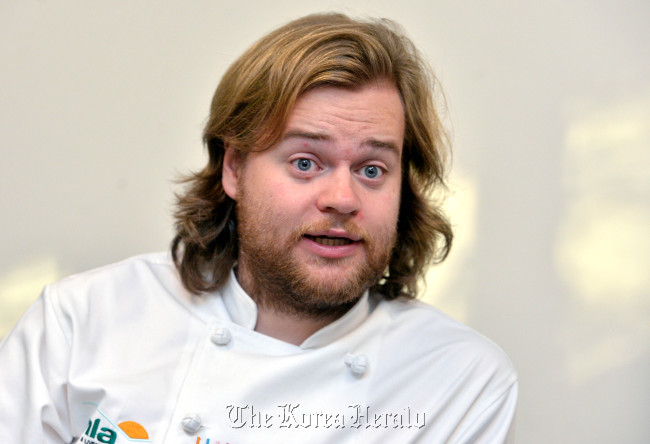Nilsson not one of ‘new Nordic’ crowd
Swedish chef-media darling steers clear of food trend bandwagon, doing own thing
By Korea HeraldPublished : Nov. 4, 2012 - 19:42
Magnus Nilsson, head chef of Faviken Magasinet in Sweden, steps onstage to teach a Master Class for the international food festival Seoul Gourmet.
Sporting his signature, long flaxen hair, Nilsson looks every bit like the guy in the photos that can be found in food magazines and newspapers around the world.
Ever since “new Nordic” cuisine became the hip food trend of the moment, Nilsson has been held up as a new Nordic poster boy of sorts, alongside Rene Redzepi of Noma in Denmark.
New Nordic started out as a manifesto that a group of chefs in Scandinavia, including Redzepi, pledged themselves to in 2004. The goal was to create cuisine from seasonal, local ingredients using techniques that combined Nordic culinary traditions with inspiration from abroad.
Sporting his signature, long flaxen hair, Nilsson looks every bit like the guy in the photos that can be found in food magazines and newspapers around the world.
Ever since “new Nordic” cuisine became the hip food trend of the moment, Nilsson has been held up as a new Nordic poster boy of sorts, alongside Rene Redzepi of Noma in Denmark.
New Nordic started out as a manifesto that a group of chefs in Scandinavia, including Redzepi, pledged themselves to in 2004. The goal was to create cuisine from seasonal, local ingredients using techniques that combined Nordic culinary traditions with inspiration from abroad.

Noma, touting the San Pellegrino “Best Restaurant in the World” title three years in a row and running, and Michelin-starred chef Redzepi have played a huge role in attracting international interest in new Nordic cuisine.
Nilsson, however, is not looking to hitch his wagon to a hot food trend or to another chef’s star.
“New Nordic is a stupid term because Scandinavian countries are large and diverse,” Nilsson, 28, told The Korea Herald in Seoul, Friday.
Nilsson does not seem to be rejecting the manifesto itself so much as the way it is getting used as a catchall phrase for Scandinavian chefs and cuisine these days.
While Nilsson’s food is often defined as such, he does not consider his cuisine to be new Nordic nor does he necessarily think new Nordic should be used as an umbrella term for the varied food cultures of the three countries comprising Scandivinia.
Yet it is hard to avoid being connected to the trend and to avoid comparisons to Noma, though Nilsson sees the two ― Faviken and Noma ― as “very different restaurants.”
Nilsson first arrived at the Faviken estate in central-northwestern Sweden five years ago.
After culinary school and several stints in Sweden, work at Paris’ L’Astrance and L’Arpege, Nilsson came back to home turf and then retired from the kitchen and focused on wine. Then, at Faviken, he found himself returning to his culinary roots, with great success.
Faviken Magasinet has been garnering accolades from prominent food magazines and newspapers and placed 34th on this year’s S. Pellegrino’s World’s 50 Best Restaurants. “The Observer” newspaper praised Nilsson, calling him “the rising star of Nordic cooking” and Faviken “one of the most innovative restaurants in the world.”
Nilsson is riding high on a wave of fame. A deluge of snaps ― especially one of him holding a big bone ― pop up when you Google his name. Invites to international food events are pouring in. Which ones did he decide to accept? The fourth annual Seoul Gourmet festival was definitely one of them.
Fresh off a cookbook tour and a showing at Le Grand Fooding fiesta in New York, Nilsson arrived in Seoul last week to chow down on some sundae (Korean blood sausage) and cook up a storm with some kimchi, Korean roe and yuja.
He also took time to teach a Master Class in Seoul on Friday, filling the audience in on what he does at Faviken.
Resourcefulness is the word that springs to mind when Nilsson describes Faviken, a countryside lodge-and-restaurant complete with hunting grounds and a farm.
Fresh produce ― grown, sourced or foraged ― is only available from May to November. Nilsson and team must rely on storage and preparation to get produce in some form or other on the table for the remaining months.
According to Nilsson, “50 percent of the hours spent working at Faviken” is devoted to sourcing produce.
In short, Nilsson gives nature full rein. He does not attempt to fly in exotic ingredients from far-off countries. He takes what he gets ― lichen and moss for example ― and makes the most of it.
“It’s logical for us to work the way we do because it gives us the best produce,” said Nilsson, who added that being at the mercy of nature is “very good for your creativity.”
In response to an audience request for some culinary wisdom, Nilsson said, “Look at what you have instead of looking at what other people do.”
By Jean Oh (oh_jean@heraldcorp.com)
-
Articles by Korea Herald














![[H.eco Forum] H.eco Forum calls for transition to clean, carbon-free energy](http://res.heraldm.com/phpwas/restmb_idxmake.php?idx=652&simg=/content/image/2024/05/22/20240522050668_0.jpg&u=20240522160838)
![[Exclusive] LACMA admits it needs research on paintings' authenticity](http://res.heraldm.com/phpwas/restmb_idxmake.php?idx=652&simg=/content/image/2024/05/22/20240522050568_0.jpg&u=20240522144337)



